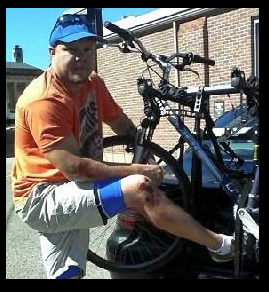02 Oct You crashed on your bicycle, now what!?
For those of you enjoying the change of seasons, autumn is a great time of year to exercise in nature’s awesome display of colors. Visiting trails for biking or hiking, or even getting out into your neighborhoods for walks or runs, can be an exceptionally wonderful experience this time of year.
The temperatures are usually comfortable for vigorous exercise, even if you might need to grab a sweatshirt while enjoying the cool air on an evening walk. The holidays will be here soon enough with cookies and festive feasts, but don’t lose your momentum, get outside while you can and move!
However, whether you’re out on a brisk walk with your dog, or on a family bike trail the unexpected fall may happen. Minor scrapes and cuts don’t usually require medical treatment, but proper care is important to avoid infection.
But if bleeding is severe or if you suspect a broken bone seek medical attention immediately. If bleeding doesn’t stop on its own apply continuous pressure for about 20 minutes and if possible elevate the wound. Don’t check to see if the wound has stopped bleeding every couple of minutes as this may damage the clot that is forming and will resume bleeding.
Soap and a washcloth may be used to cleanse around the wound, but to rinse out the wound use clear water, as soap may irritate the wound. If debris remains use tweezers cleaned with alcohol to remove particles. If you’re not able to remove all the debris see your doctor.
Once the wound is clean and dry, apply a thin layer of antibiotic ointment and cover with a bandage. Once the wound has had some time to heal exposure to air will speed healing. Daily dressing changes are advised and if you develop sensitivity to adhesive try adhesive-free dressings or use sterile gauze with paper tape.
Watch for signs of infection such as redness, warmth, increasing pain, swelling, and drainage. See your doctor if your wound isn’t healing properly. A tetanus shot is recommended every 10 years, but if you have a deep or dirty wound and your last shot was more than 5 years ago your doctor may recommend a booster.
We all know wearing a bike helmet is the number one thing we can do to protect ourselves from head trauma and death, and yes, even wear one on the family bike trail. If anything you are setting an example for your children that protecting our noggin is so very important. According to the website www.helmets.org bicycle helmets reduce the risk of head injury and the risk of brain injury, and it is estimated that 75 percent of bicycle-related fatalities among children could have been prevented with a bike helmet. Bike helmets are very accessible and it just makes sense.
Bill Buckwalter, owner of Ride On bicycle shop in Wooster, Ohio, told me more bike accidents actually happen on bike trails because people let their guards down and think nothing can happen.
Despite being an experienced cyclist, I recently had my first crach when I didn’t realize how different the level of the grade was in the bike path lane I changing into was. I crashed going about 20 mph. Although I received some pretty bad road rash on my right knee, elbow and shoulder, I’m truly glad I was wearing a helmet. Fortunately, scrapes and cuts were the extent of my injuries.
Note: Some information from www.mayoclinic.com was used for this report.

At Home Fitness blogger Aaron Dorksen has tips for how to handle treatment after a bicycle crash, which he experienced recently.
At Home Fitness consultant Aaron Dorksen’s blog deals with a variety of fitness topics, ranging from workout tips, motivational ideas and feature stories on how exercise impacts people’s lives. Consult a doctor before making any significant changes in your exercise routine or diet. E-mail him with comments, questions or ideas for future blogs at aaron@athomefitness.com

